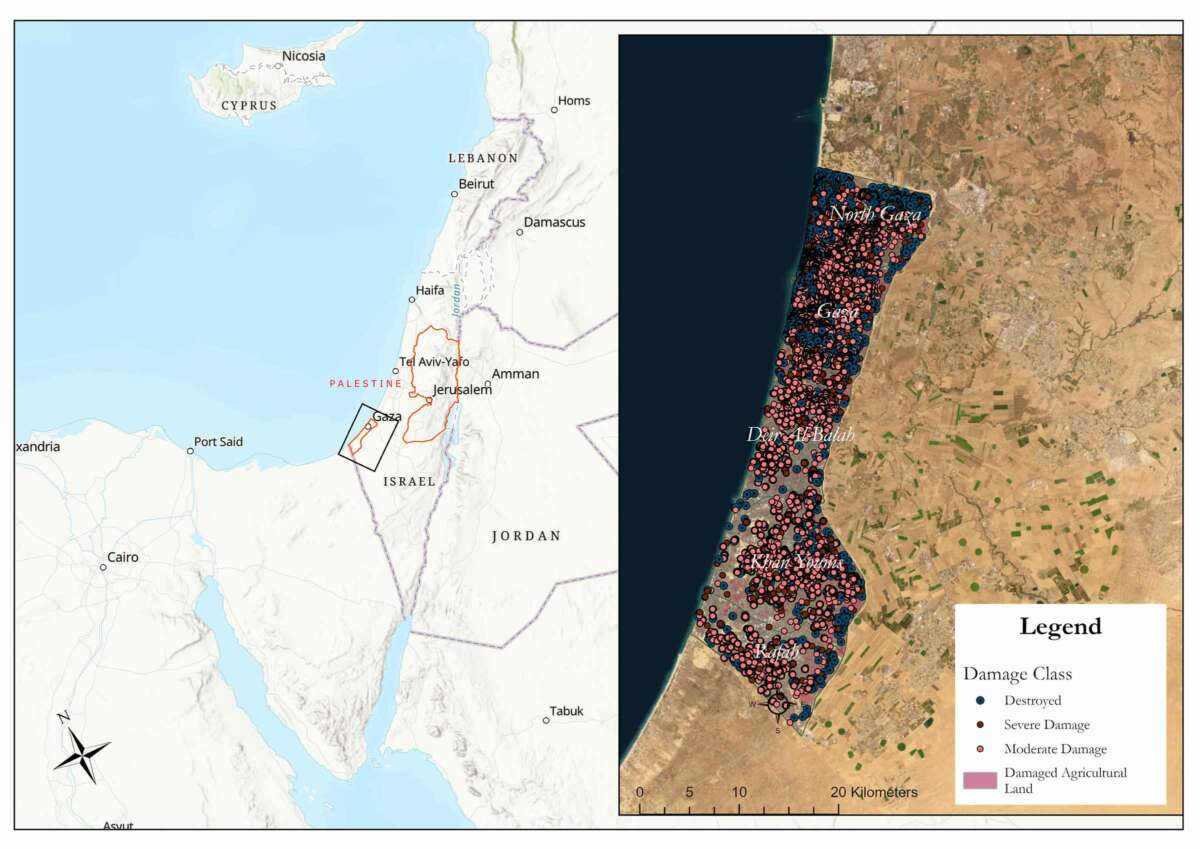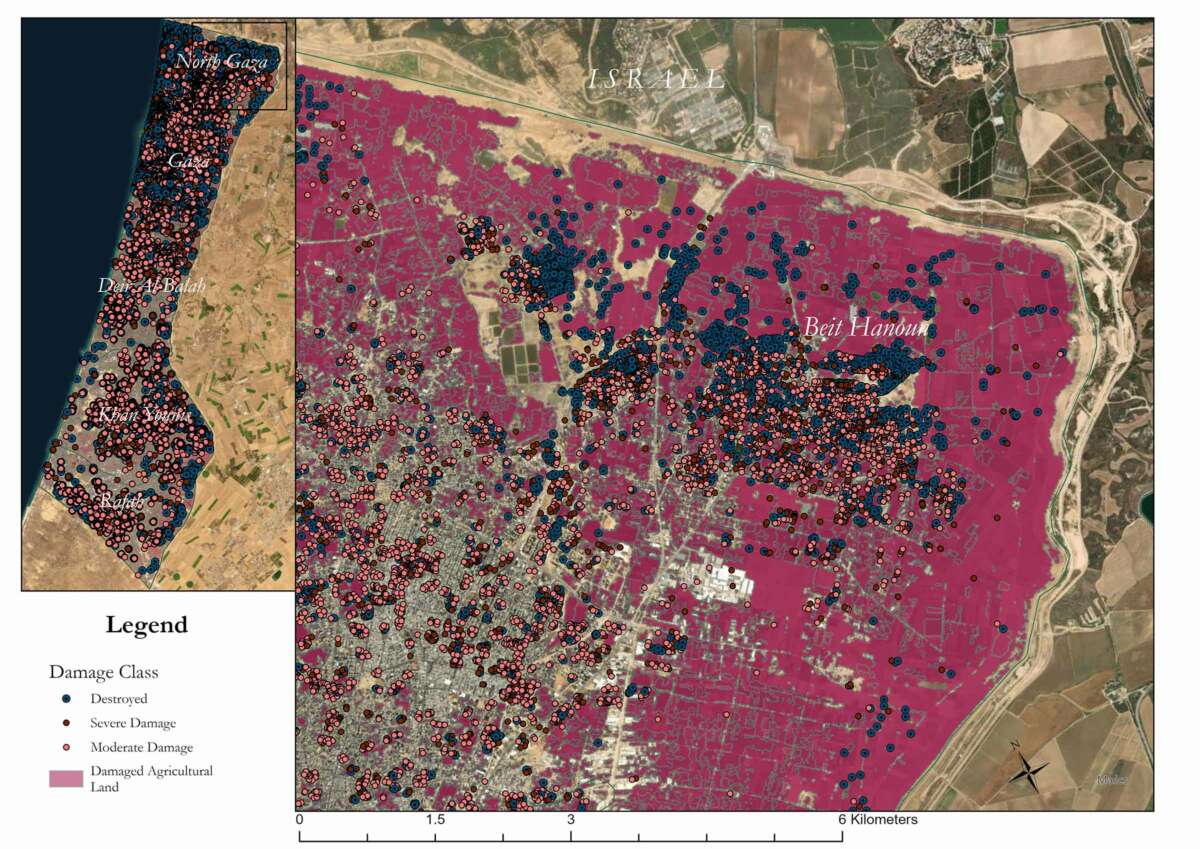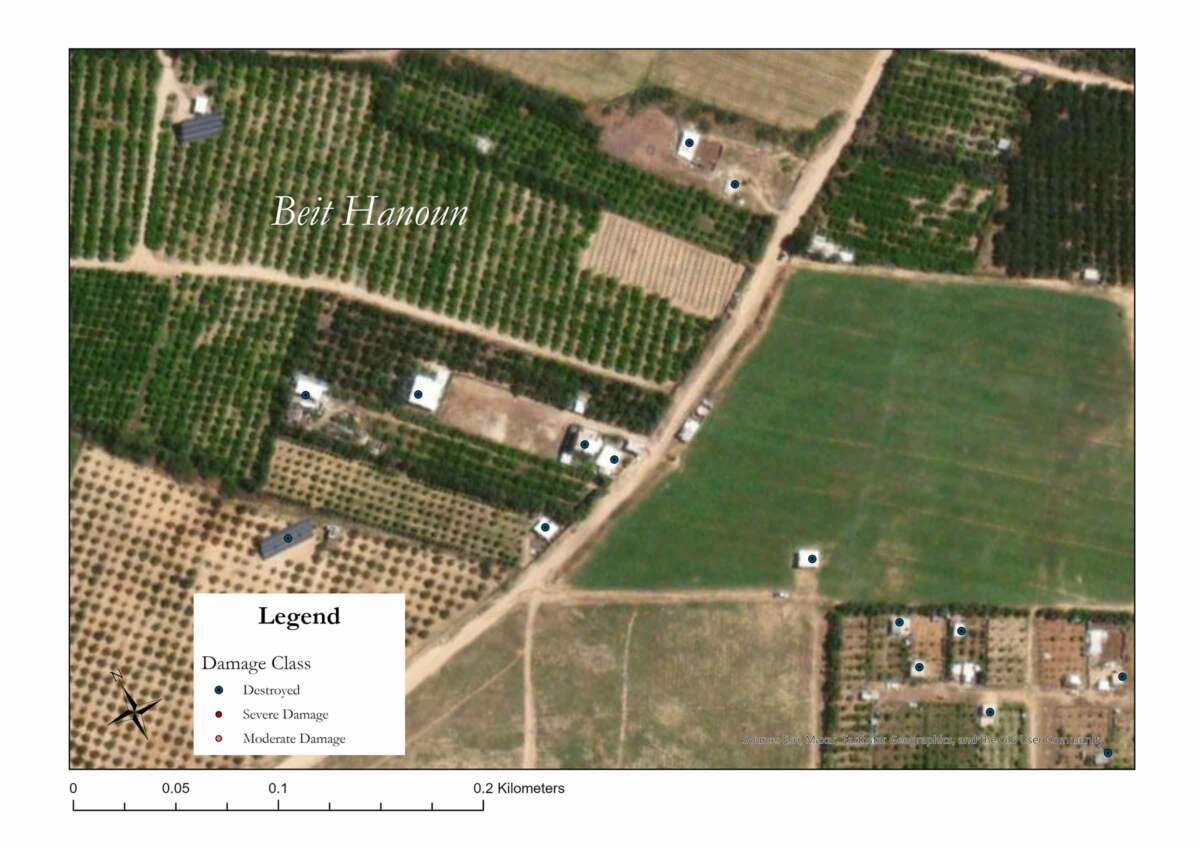The Biden administration is expanding the surveillance of immigrants to unprecedented levels.
By Maurizio Guerrero , PRISM
January 10, 2024

U.S. National Guard soldiers patrol the Rio Grande at the U.S.-Mexico border on January 9, 2024, in Eagle Pass, Texas
.PHOTO BY JOHN MOORE / GETTY IMAGES
Did you know that Truthout is a nonprofit and independently funded by readers like you? If you value what we do, please support our work with a donation.
Aided by electronic monitoring and data mining companies that extract, aggregate, and sell personal information from tens of thousands of private and public digital databases without the consent of individuals, the Biden administration is expanding the surveillance of immigrants to unprecedented levels — stifling dissent and political organizing and sowing fear among non-citizens and civil rights advocates.
At the core of the spreading surveillance lies LexisNexis Risk Solutions, whose Accurint tool produces comprehensive dossiers with identifying information, court data, and details of relatives, associates, and social media usage of practically all U.S. residents, citizens and non-citizens alike. It also incorporates license plate reader data, which can determine where a person was at various times, and real-time information on county jails’ bookings, which allows Immigration and Customs Enforcement (ICE) agents to apprehend people upon release.
Though the Biden administration requested an approximately $100 million cut from the fiscal year 2023 to the fiscal year 2024 budget for ICE, an agency denounced for using private contractors to abuse immigrants, both the House and the Senate proposed significant budget increases. If approved, ICE will have its largest budget, at least $9.1 billion, partly to broaden what is already the most extensive surveillance apparatus in U.S. history.
“This mass surveillance program of ICE instills fear and chills organizing political activity,” said Laura Rivera, a senior staff attorney at Just Futures Law, one of the grassroots organizations at the forefront of uncovering ICE’s surveillance network. “It has repercussions in all areas of life from workplaces to religious institutions to schools and homes.”

Police Tech Isn’t Designed to Be Accurate — It’s Made to Exert Social Control
Policing technologies are inaccurate by design.
By James Kilgore , TRUTHOUT December 16, 2023
Other companies have paved the way for LexisNexis Risk Solutions and the taking over of immigration enforcement by surveillance capitalism — or the mining of data to repackage and exploit it for profit without the consent of individuals, shaping their behavior as consumers and, in this case, as non-citizens.
The Canadian information conglomerate Thomson Reuters’ CLEAR tool also aggregates information about practically all U.S. residents — more than 400 million names and records. Though CLEAR contracted with ICE from 2015 to 2021, Thomson Reuters has a current five-year contract with the Department of Homeland Security, which houses ICE, for more than $22 million, although allegedly not for CLEAR. The data collected by CLEAR led to “further human rights abuses,” according to the Electronic Frontier Foundation, and after years of activists’ pressure, Thomson Reuters signed the United Nations Guiding Principles on Business and Human Rights in 2022.
Similar concerns have not persuaded LexisNexis Risk Solutions and other data aggregators to cancel their contracts with ICE, despite its documented human rights violations. LexisNexis is selling individuals’ reports to the agency based on information extracted from 10,000 different databases through a five-year contract potentially worth $22.1 million until 2026. Another corporation has been central to ICE’s surveillance apparatus: Palantir, which, since 2011, provides ICE with artificial intelligence tools to create surveillance reports and has a current five-year contract for almost $96 million.
Between 2008 and 2021, ICE has spent almost $2.8 billion on data collection and data-sharing initiatives, building a domestic surveillance apparatus that rivals that of the Federal Bureau of Investigations (FBI), according to the Center on Privacy & Technology of Georgetown Law. In the last few years, this surveillance has expanded and decentralized.
Surveillance used to be primarily conducted by ICE’s National Criminal Analysis and Targeting Center (NCATC) and by the Pacific Enforcement Response Center (PERC) — though not anymore. Similar to Thomson Reuters’ CLEAR, LexisNexis Risk Solutions allows ICE field agents to obtain immediate encyclopedic information on 276 million consumers in the U.S. Court documents show that ICE’s LexisNexis tools were consulted more than 1.2 million times and produced more than 300,000 reports in only seven months in 2021.
ICE agents operate in a legal gray area using the tools of a vastly unregulated industry. Immigrant communities, however, have not stopped organizing and responding, said Rivera. Just Futures Law represents three advocates and two grassroots organizations — Mijente and Organized Communities Against Deportations — in a lawsuit filed in August 2022 against LexisNexis Risk Solutions for collecting their data without consent.
“Each day that LexisNexis is allowed to continue its illegal activities, plaintiffs suffer immediate and irreparable injuries,” claims the lawsuit, “including the chilling of their core constitutional rights of freedom of association and freedom of speech, violations of their rights to privacy, deprivations of the economic value of their own personal data, and injuries to their peace of mind and well-being.”
Breaking Immigrants’ Systems of Support
Surveillance capitalism has contributed to creating an environment of fear among immigrants — an uncertainty about who will be targeted for detention and deportation and why, which restricts their access to essential services and their willingness to denounce abuse, say advocates.
Claudia Marchan, an immigrant rights advocate in Chicago, “felt scared” when she learned of the extent of the information that LexisNexis was collecting about her to sell it to ICE and others. As the executive director of Northern Illinois Justice for Our Neighbors and a member of the Illinois Coalition for Immigrant and Refugee Rights, Marchan was also concerned for the scores of undocumented immigrants she dealt with daily.
“I felt really scared for my family members who could be at risk of being deported,” she told Prism. Marchan, who emigrated from Mexico as a 4-year-old, encourages fellow immigrants to overcome their misgivings about sharing information with government officials to access public services. However, after learning that her LexisNexis report included even her full social security number without redactions, “I understand their fear,” she said.
For Marchan, a plaintiff in the lawsuit against LexisNexis Risk Solutions, one of the purposes of ICE’s surveillance is to paralyze immigrant communities. “How do they break down the systems of support and the organizing we have in place?” she said. “How do they make people scared? I think that is very, very intentional.” Marchan and her co-plaintiffs dread that LexisNexis reports on them will make them “targets for retaliation” for their work advocating for immigrant rights, according to the complaint, and that ICE will use the “information to deport them.”
ICE has a record of retaliating against immigrants who denounce mistreatment, often ending in their deportation. Aided by private contractors, ICE has used prolonged solitary confinement, medical neglect, forceful transfers, and threats of removal to silence immigrants, as Prism reported. The agency’s spokespersons did not respond to a request for comment.
ICE field agents have also used database searches, such as Thomson Reuters’ CLEAR, to arrest immigrants simply because they can. A bilingual teacher aide in Oregon who “matched none of the agency’s stated enforcement priorities, even under [the administration of] Trump,” was detained after a data aggregator yielded his personal information, according to a 2019 investigative report. Thomson Reuters did respond to a request for comment.
That power, available to field agents, is especially threatening to immigrant rights activists. Every interaction of a non-citizen with a government agency, a utility company, or a social media platform, or even their mere presence in a public space, could be used to identify them and, eventually, to detain and deport them.
“One of the horrible consequences of the system of surveillance is that the more people engage in the basic social structures that we have in this country, the more legible they become … and thus [they] create more data points that can be used to identify, profile, find, and target them,” said Alli Finn, the senior organizer and researcher at Surveillance Resistance Lab.
While LexisNexis perpetuates fear in immigrant communities, its parent company, the British multinational RELX Group, headquartered in London, announced an 9% increase in revenues in 2022. The price paid by society has been steep.
These tools, said Finn, are “deeply influencing the way that people live their lives,” not only as consumers, but also as members of a democratic society. Surveillance capitalism, they said, is driving “the suppression and repression of free speech, protests, and the ability to speak out against abuses.”
Skirting Laws for Profit
LexisNexis’ contracts with ICE are budgeted through Fugitive Operations, a program created in 2003 allegedly to locate and apprehend dangerous individuals with removal orders. In an emailed response to Prism’s queries, Paul Eckloff, LexisNexis Special Services’ senior director of public relations, stated that the company complies with current federal policies, which “emphasize a respect for human rights, and focus on threats to national security, public safety, and security at the border.” Eckloff added, “the Department of Homeland Security must use our services in compliance with these principles.”
However, the vast majority of the program’s apprehensions quickly became “low-priority noncriminal fugitive aliens,” not “threats,” showed the Migration Policy Institute in 2009. Fugitive Operations’ own handbook states that its agents can detain individuals for “reasonable suspicion” they are “unlawfully present in the United States.” As of Dec. 31, 66.8% of individuals held in ICE detention had no criminal record, while many more had only minor offenses, including traffic violations. Despite the data, ICE’s Fugitive Operations program displays a quote on its website: “We remove criminals from our communities.” Under this overblown risk, surveillance capitalism is thriving with ICE’s support.
“Corporations and the state use fear very deliberately to get what they want, whether that’s profit or the criminalization of marginalized groups,” said Rumsha Sajid, the national field organizer on policing and surveillance at MediaJustice, a grassroots organization advocating for social justice in the digital landscape. “Surveillance is not just a threat in and of itself, it’s criminalization, when every move is under a microscope and when people are surveilled more because of immigrant status or because of their race.”
The Department of Homeland Security lists two additional companies as top Fugitive Operations contractors: Thomson Reuters Special Services and ThunderCat, an information technology reseller that offers to solve its “customer problems in and around the data center.” A major U.S. government contractor, ThunderCat is nearing the end of a 12-year contract worth up to $6.3 billion with the Department of Homeland Security and at least two active contracts with ICE for an additional $13 million. ThunderCat’s partners are LexisNexis and Thomson Reuters, Google, and Amazon, among dozens of other companies.
Data aggregators — also called data brokers — have become the backbone of immigration enforcement in the U.S. interior, even though they cross legal and ethical lines, say advocates.
LexisNexis accesses and sells information that ICE would be unable to obtain without a subpoena, court order, or other legal process, according to the Center on Privacy & Technology. “ICE’s reliance on data brokers evades public scrutiny and helps the agency circumvent statutory and constitutional privacy protections,” it stated in a 2022 report.
According to the Electronic Privacy Information Center, while ICE’s investigators cannot directly intercept oral, wire, or electronic communication, they face no explicit restrictions for using commercially available data, which can be as invasive if not more.
In 2022, the American Civil Liberties Union (ACLU) denounced data aggregators Venntel and Babel Street, the latter of which has a five-year contract with ICE for up to $6.5 million, for “sidestepping our Fourth Amendment right against unreasonable government searches and seizures by buying access to, and using, huge volumes of people’s cell phone location information quietly extracted from smartphone apps.”
The efforts by local jurisdictions to rein in ICE enforcement operations by declaring themselves sanctuaries — limiting cooperation with immigration authorities — have been circumvented by data aggregators. A 2022 report from the Colorado Immigrant Rights Coalition, titled “Sabotaging Sanctuary,” stated that ICE contracted data aggregator Appriss Solutions, a subsidiary of LexisNexis, the previous year for “the express purpose of getting around sanctuary laws,” which means skirting ordinances, regulations, resolutions, and policies approved by more than 200 jurisdictions across the U.S.
Although 12 states in the U.S. offer some protection against data collection, Congress’ attempts to regulate data aggregators have failed in the face of deep-pocketed opponents.
RELX Group — LexisNexis’ parent company — spent more than $5 million in 2022 and 2023 in lobbying Congress, according to Open Secrets. The conglomerate focused significantly on the American Data Privacy and Protection Act of 2022 and the Data Privacy Act of 2023, which would have restricted the ability of private and public entities to collect and sell information and would have provided individuals the right to opt out of data collection. For its lobbying, RELX extensively used the so-called revolving door — when a former official or Congress staffer lobbies for the industry they oversaw, offering privileged knowledge and access. In 2023, 35 of the company’s 50 lobbyists were “revolvers,” Open Secrets’ documents show.
Since at least 2014, the executive branch has attempted to regulate the data broker industry, which operates virtually without federal oversight. The Federal Trade Commission (FTC) launched a “rulemaking proceeding” in 2022 that could eventually produce a national standard, while the Consumer Financial Protection Bureau (CFPB) announced in August its plans to develop guidelines to prevent misuse and abuse by data aggregators.
“There needs to be a reining in of data brokers who have long functioned with impunity,” said Sajid. “We need federal agencies like the FTC and the CFPB to create rules to hold these corporations accountable.”
Tracking Immigrants’ Every Move
Data aggregators are not the only tools ICE uses to bolster its surveillance apparatus — electronic monitoring, or, according to its official moniker, alternatives to detention (ATDs), has expanded rapidly during the Biden administration. Immigrants are electronically monitored with GPS ankle monitors or shackles and, more often, with a phone app called SmartLink, which requires non-detained individuals in immigration proceedings to check in with ICE through geolocation and voice or facial recognition. Since April, ICE launched another ATD as part of a pilot program: a wrist monitor.
As of December 2023, more than 190,000 individuals were subjected to electronic monitoring, also known as digital prison or e-carceration, more than double the figure at the end of the Trump administration. The prevalence of electronic monitoring has not meant fewer detainees, as more than 37,000 individuals in immigration proceedings remain in ICE jails. One corporation has been the primary beneficiary of ICE’s expansion of electronic monitoring: GEO Group, one of the largest private prison companies in the U.S. and one of ICE’s top contractors, with ongoing contracts worth up to $1.9 billion.
GEO Group is also the parent company of BI, Inc., which holds a five-year contract worth up to $2.2 billion. BI is ICE’s sole provider of both ankle monitors and SmartLink, through which immigrants have to check in weekly or biweekly, causing them “immense anxiety,” according to a 2023 report by the African Bureau of Immigrants and Social Affairs based on more than 180 interviews with monitored individuals.
“We are always afraid,” said Juan, who is using a pseudonym to avoid affecting his asylum case. Juan is a 28-year-old immigrant from Honduras who requested asylum with his wife and their daughter in 2019 and who, after wearing an ankle monitor for almost two years, now checks in through SmartLink. Juan has lost three jobs because ICE agents “frequently change the rules.” The check-in days can be switched with short notice, he told Prism, while the time of the check-in calls varies widely — from early mornings to late afternoons.
Juan said that he has received ICE calls when he had to leave his apartment during check-in days to tend to emergencies. So, he is certain that SmartLink tracks his every move, even though ICE has publicly assured that the app is “not capable of persistent tracking when loaded on a participant provided device.”
Juan said he was falsely accused by ICE officers of failing to comply with the check-ins, for which he was detained for hours and threatened with deportation. “That has deeply affected me mentally because if I get deported, who will take care of my family?” he said. SmartLink’s geolocation could also jeopardize immigrants with whom Juan interacts — which adds to his anxiety.
Did you know that Truthout is a nonprofit and independently funded by readers like you? If you value what we do, please support our work with a donation.
Aided by electronic monitoring and data mining companies that extract, aggregate, and sell personal information from tens of thousands of private and public digital databases without the consent of individuals, the Biden administration is expanding the surveillance of immigrants to unprecedented levels — stifling dissent and political organizing and sowing fear among non-citizens and civil rights advocates.
At the core of the spreading surveillance lies LexisNexis Risk Solutions, whose Accurint tool produces comprehensive dossiers with identifying information, court data, and details of relatives, associates, and social media usage of practically all U.S. residents, citizens and non-citizens alike. It also incorporates license plate reader data, which can determine where a person was at various times, and real-time information on county jails’ bookings, which allows Immigration and Customs Enforcement (ICE) agents to apprehend people upon release.
Though the Biden administration requested an approximately $100 million cut from the fiscal year 2023 to the fiscal year 2024 budget for ICE, an agency denounced for using private contractors to abuse immigrants, both the House and the Senate proposed significant budget increases. If approved, ICE will have its largest budget, at least $9.1 billion, partly to broaden what is already the most extensive surveillance apparatus in U.S. history.
“This mass surveillance program of ICE instills fear and chills organizing political activity,” said Laura Rivera, a senior staff attorney at Just Futures Law, one of the grassroots organizations at the forefront of uncovering ICE’s surveillance network. “It has repercussions in all areas of life from workplaces to religious institutions to schools and homes.”

Police Tech Isn’t Designed to Be Accurate — It’s Made to Exert Social Control
Policing technologies are inaccurate by design.
By James Kilgore , TRUTHOUT December 16, 2023
Other companies have paved the way for LexisNexis Risk Solutions and the taking over of immigration enforcement by surveillance capitalism — or the mining of data to repackage and exploit it for profit without the consent of individuals, shaping their behavior as consumers and, in this case, as non-citizens.
The Canadian information conglomerate Thomson Reuters’ CLEAR tool also aggregates information about practically all U.S. residents — more than 400 million names and records. Though CLEAR contracted with ICE from 2015 to 2021, Thomson Reuters has a current five-year contract with the Department of Homeland Security, which houses ICE, for more than $22 million, although allegedly not for CLEAR. The data collected by CLEAR led to “further human rights abuses,” according to the Electronic Frontier Foundation, and after years of activists’ pressure, Thomson Reuters signed the United Nations Guiding Principles on Business and Human Rights in 2022.
Similar concerns have not persuaded LexisNexis Risk Solutions and other data aggregators to cancel their contracts with ICE, despite its documented human rights violations. LexisNexis is selling individuals’ reports to the agency based on information extracted from 10,000 different databases through a five-year contract potentially worth $22.1 million until 2026. Another corporation has been central to ICE’s surveillance apparatus: Palantir, which, since 2011, provides ICE with artificial intelligence tools to create surveillance reports and has a current five-year contract for almost $96 million.
Between 2008 and 2021, ICE has spent almost $2.8 billion on data collection and data-sharing initiatives, building a domestic surveillance apparatus that rivals that of the Federal Bureau of Investigations (FBI), according to the Center on Privacy & Technology of Georgetown Law. In the last few years, this surveillance has expanded and decentralized.
Surveillance used to be primarily conducted by ICE’s National Criminal Analysis and Targeting Center (NCATC) and by the Pacific Enforcement Response Center (PERC) — though not anymore. Similar to Thomson Reuters’ CLEAR, LexisNexis Risk Solutions allows ICE field agents to obtain immediate encyclopedic information on 276 million consumers in the U.S. Court documents show that ICE’s LexisNexis tools were consulted more than 1.2 million times and produced more than 300,000 reports in only seven months in 2021.
ICE agents operate in a legal gray area using the tools of a vastly unregulated industry. Immigrant communities, however, have not stopped organizing and responding, said Rivera. Just Futures Law represents three advocates and two grassroots organizations — Mijente and Organized Communities Against Deportations — in a lawsuit filed in August 2022 against LexisNexis Risk Solutions for collecting their data without consent.
“Each day that LexisNexis is allowed to continue its illegal activities, plaintiffs suffer immediate and irreparable injuries,” claims the lawsuit, “including the chilling of their core constitutional rights of freedom of association and freedom of speech, violations of their rights to privacy, deprivations of the economic value of their own personal data, and injuries to their peace of mind and well-being.”
Breaking Immigrants’ Systems of Support
Surveillance capitalism has contributed to creating an environment of fear among immigrants — an uncertainty about who will be targeted for detention and deportation and why, which restricts their access to essential services and their willingness to denounce abuse, say advocates.
Claudia Marchan, an immigrant rights advocate in Chicago, “felt scared” when she learned of the extent of the information that LexisNexis was collecting about her to sell it to ICE and others. As the executive director of Northern Illinois Justice for Our Neighbors and a member of the Illinois Coalition for Immigrant and Refugee Rights, Marchan was also concerned for the scores of undocumented immigrants she dealt with daily.
“I felt really scared for my family members who could be at risk of being deported,” she told Prism. Marchan, who emigrated from Mexico as a 4-year-old, encourages fellow immigrants to overcome their misgivings about sharing information with government officials to access public services. However, after learning that her LexisNexis report included even her full social security number without redactions, “I understand their fear,” she said.
For Marchan, a plaintiff in the lawsuit against LexisNexis Risk Solutions, one of the purposes of ICE’s surveillance is to paralyze immigrant communities. “How do they break down the systems of support and the organizing we have in place?” she said. “How do they make people scared? I think that is very, very intentional.” Marchan and her co-plaintiffs dread that LexisNexis reports on them will make them “targets for retaliation” for their work advocating for immigrant rights, according to the complaint, and that ICE will use the “information to deport them.”
ICE has a record of retaliating against immigrants who denounce mistreatment, often ending in their deportation. Aided by private contractors, ICE has used prolonged solitary confinement, medical neglect, forceful transfers, and threats of removal to silence immigrants, as Prism reported. The agency’s spokespersons did not respond to a request for comment.
ICE field agents have also used database searches, such as Thomson Reuters’ CLEAR, to arrest immigrants simply because they can. A bilingual teacher aide in Oregon who “matched none of the agency’s stated enforcement priorities, even under [the administration of] Trump,” was detained after a data aggregator yielded his personal information, according to a 2019 investigative report. Thomson Reuters did respond to a request for comment.
That power, available to field agents, is especially threatening to immigrant rights activists. Every interaction of a non-citizen with a government agency, a utility company, or a social media platform, or even their mere presence in a public space, could be used to identify them and, eventually, to detain and deport them.
“One of the horrible consequences of the system of surveillance is that the more people engage in the basic social structures that we have in this country, the more legible they become … and thus [they] create more data points that can be used to identify, profile, find, and target them,” said Alli Finn, the senior organizer and researcher at Surveillance Resistance Lab.
While LexisNexis perpetuates fear in immigrant communities, its parent company, the British multinational RELX Group, headquartered in London, announced an 9% increase in revenues in 2022. The price paid by society has been steep.
These tools, said Finn, are “deeply influencing the way that people live their lives,” not only as consumers, but also as members of a democratic society. Surveillance capitalism, they said, is driving “the suppression and repression of free speech, protests, and the ability to speak out against abuses.”
Skirting Laws for Profit
LexisNexis’ contracts with ICE are budgeted through Fugitive Operations, a program created in 2003 allegedly to locate and apprehend dangerous individuals with removal orders. In an emailed response to Prism’s queries, Paul Eckloff, LexisNexis Special Services’ senior director of public relations, stated that the company complies with current federal policies, which “emphasize a respect for human rights, and focus on threats to national security, public safety, and security at the border.” Eckloff added, “the Department of Homeland Security must use our services in compliance with these principles.”
However, the vast majority of the program’s apprehensions quickly became “low-priority noncriminal fugitive aliens,” not “threats,” showed the Migration Policy Institute in 2009. Fugitive Operations’ own handbook states that its agents can detain individuals for “reasonable suspicion” they are “unlawfully present in the United States.” As of Dec. 31, 66.8% of individuals held in ICE detention had no criminal record, while many more had only minor offenses, including traffic violations. Despite the data, ICE’s Fugitive Operations program displays a quote on its website: “We remove criminals from our communities.” Under this overblown risk, surveillance capitalism is thriving with ICE’s support.
“Corporations and the state use fear very deliberately to get what they want, whether that’s profit or the criminalization of marginalized groups,” said Rumsha Sajid, the national field organizer on policing and surveillance at MediaJustice, a grassroots organization advocating for social justice in the digital landscape. “Surveillance is not just a threat in and of itself, it’s criminalization, when every move is under a microscope and when people are surveilled more because of immigrant status or because of their race.”
The Department of Homeland Security lists two additional companies as top Fugitive Operations contractors: Thomson Reuters Special Services and ThunderCat, an information technology reseller that offers to solve its “customer problems in and around the data center.” A major U.S. government contractor, ThunderCat is nearing the end of a 12-year contract worth up to $6.3 billion with the Department of Homeland Security and at least two active contracts with ICE for an additional $13 million. ThunderCat’s partners are LexisNexis and Thomson Reuters, Google, and Amazon, among dozens of other companies.
Data aggregators — also called data brokers — have become the backbone of immigration enforcement in the U.S. interior, even though they cross legal and ethical lines, say advocates.
LexisNexis accesses and sells information that ICE would be unable to obtain without a subpoena, court order, or other legal process, according to the Center on Privacy & Technology. “ICE’s reliance on data brokers evades public scrutiny and helps the agency circumvent statutory and constitutional privacy protections,” it stated in a 2022 report.
According to the Electronic Privacy Information Center, while ICE’s investigators cannot directly intercept oral, wire, or electronic communication, they face no explicit restrictions for using commercially available data, which can be as invasive if not more.
In 2022, the American Civil Liberties Union (ACLU) denounced data aggregators Venntel and Babel Street, the latter of which has a five-year contract with ICE for up to $6.5 million, for “sidestepping our Fourth Amendment right against unreasonable government searches and seizures by buying access to, and using, huge volumes of people’s cell phone location information quietly extracted from smartphone apps.”
The efforts by local jurisdictions to rein in ICE enforcement operations by declaring themselves sanctuaries — limiting cooperation with immigration authorities — have been circumvented by data aggregators. A 2022 report from the Colorado Immigrant Rights Coalition, titled “Sabotaging Sanctuary,” stated that ICE contracted data aggregator Appriss Solutions, a subsidiary of LexisNexis, the previous year for “the express purpose of getting around sanctuary laws,” which means skirting ordinances, regulations, resolutions, and policies approved by more than 200 jurisdictions across the U.S.
Although 12 states in the U.S. offer some protection against data collection, Congress’ attempts to regulate data aggregators have failed in the face of deep-pocketed opponents.
RELX Group — LexisNexis’ parent company — spent more than $5 million in 2022 and 2023 in lobbying Congress, according to Open Secrets. The conglomerate focused significantly on the American Data Privacy and Protection Act of 2022 and the Data Privacy Act of 2023, which would have restricted the ability of private and public entities to collect and sell information and would have provided individuals the right to opt out of data collection. For its lobbying, RELX extensively used the so-called revolving door — when a former official or Congress staffer lobbies for the industry they oversaw, offering privileged knowledge and access. In 2023, 35 of the company’s 50 lobbyists were “revolvers,” Open Secrets’ documents show.
Since at least 2014, the executive branch has attempted to regulate the data broker industry, which operates virtually without federal oversight. The Federal Trade Commission (FTC) launched a “rulemaking proceeding” in 2022 that could eventually produce a national standard, while the Consumer Financial Protection Bureau (CFPB) announced in August its plans to develop guidelines to prevent misuse and abuse by data aggregators.
“There needs to be a reining in of data brokers who have long functioned with impunity,” said Sajid. “We need federal agencies like the FTC and the CFPB to create rules to hold these corporations accountable.”
Tracking Immigrants’ Every Move
Data aggregators are not the only tools ICE uses to bolster its surveillance apparatus — electronic monitoring, or, according to its official moniker, alternatives to detention (ATDs), has expanded rapidly during the Biden administration. Immigrants are electronically monitored with GPS ankle monitors or shackles and, more often, with a phone app called SmartLink, which requires non-detained individuals in immigration proceedings to check in with ICE through geolocation and voice or facial recognition. Since April, ICE launched another ATD as part of a pilot program: a wrist monitor.
As of December 2023, more than 190,000 individuals were subjected to electronic monitoring, also known as digital prison or e-carceration, more than double the figure at the end of the Trump administration. The prevalence of electronic monitoring has not meant fewer detainees, as more than 37,000 individuals in immigration proceedings remain in ICE jails. One corporation has been the primary beneficiary of ICE’s expansion of electronic monitoring: GEO Group, one of the largest private prison companies in the U.S. and one of ICE’s top contractors, with ongoing contracts worth up to $1.9 billion.
GEO Group is also the parent company of BI, Inc., which holds a five-year contract worth up to $2.2 billion. BI is ICE’s sole provider of both ankle monitors and SmartLink, through which immigrants have to check in weekly or biweekly, causing them “immense anxiety,” according to a 2023 report by the African Bureau of Immigrants and Social Affairs based on more than 180 interviews with monitored individuals.
“We are always afraid,” said Juan, who is using a pseudonym to avoid affecting his asylum case. Juan is a 28-year-old immigrant from Honduras who requested asylum with his wife and their daughter in 2019 and who, after wearing an ankle monitor for almost two years, now checks in through SmartLink. Juan has lost three jobs because ICE agents “frequently change the rules.” The check-in days can be switched with short notice, he told Prism, while the time of the check-in calls varies widely — from early mornings to late afternoons.
Juan said that he has received ICE calls when he had to leave his apartment during check-in days to tend to emergencies. So, he is certain that SmartLink tracks his every move, even though ICE has publicly assured that the app is “not capable of persistent tracking when loaded on a participant provided device.”
Juan said he was falsely accused by ICE officers of failing to comply with the check-ins, for which he was detained for hours and threatened with deportation. “That has deeply affected me mentally because if I get deported, who will take care of my family?” he said. SmartLink’s geolocation could also jeopardize immigrants with whom Juan interacts — which adds to his anxiety.
Tracking data provided by BI has also led to mass detentions. In 2018, BI employees in Manassas, Virginia, allegedly provided precise geolocation data to ICE that led to the arrest of 40 individuals, according to documents obtained through a Freedom of Information Act (FOIA) request.
As BI extended the surveillance apparatus, its parent company, GEO Group, spent almost $1.9 million in lobbying Congress on issues, including “alternatives to detention,” through the work of 13 lobbyists, 12 of whom were “revolvers.” Moreover, the former government official in charge of “all agency contracting” at ICE went to work directly for GEO Group in 2018, while one of GEO Group’s leading corporate attorneys was appointed to federal law enforcement immediately after leaving the company.
Corporations offering surveillance “solutions” collaborate closely with the federal government, benefitting “from a broader political climate of scapegoating immigrants and this toxic conversation around the border,” said Setareh Ghandehari, advocacy director at Detention Watch Network, a nonprofit advocating to abolish immigrant detention. “We’re in a political climate where there’s a give and take between politicians and private prison corporations. They’re really feeding into each other.”
That collaboration could mean an exponential increase in immigrants’ surveillance shortly. In August, the Department of Homeland Security requested proposals for a program dubbed Release and Reporting Management, which could potentially mean that the 5.7 million individuals in immigration proceedings would be electronically monitored — almost 30 times more than today. The program has not been funded for the fiscal year 2024, but according to reported investors’ calls, private prison corporations are eager to profit from a significant expansion of immigrants’ e-carceration.
“People’s lives are being shaped by the relationship between corporations and a government whose orientation toward immigration is enforcement, deterrence, and punishment,” said Ghandehari. They “create an environment of oppression not just for migrants, but for all of us.”
Despite the growing influence of surveillance capitalism in immigration enforcement, advocates have scored victories against the apparatus. As of December 2023, several bills offering some protection against data collection are being considered in state legislatures and may soon join privacy laws in a dozen states. In Congress, the Dignity Act, a bill with bipartisan support, would grant legal status to undocumented immigrants already living in the U.S., among other benefits, while the BREATHE Act aims at dismantling the punitive state, including abolishing ICE and investing in community-based approaches to public safety.
Courts have also been avenues of resistance. The lawsuit in which Marchan is a plaintiff has moved to the Circuit Court of Cook County, Illinois, a federal court, where plaintiffs are demanding compensation from LexisNexis Risk Solutions for collecting, aggregating, and selling their data without consent. The trial is expected to begin this fall.
The state, with the help of corporations with vested interests in the expansion of surveillance, “will try to control the lives and autonomy of Black, brown, and immigrant people,” said Rivera from Just Futures Law. “But Black, brown, and immigrant people are always in resistance and organizing to denounce this and to create safety in our communities.”
Prism is an independent and nonprofit newsroom led by journalists of color. We report from the ground up and at the intersections of injustice.
The state, with the help of corporations with vested interests in the expansion of surveillance, “will try to control the lives and autonomy of Black, brown, and immigrant people,” said Rivera from Just Futures Law. “But Black, brown, and immigrant people are always in resistance and organizing to denounce this and to create safety in our communities.”
Prism is an independent and nonprofit newsroom led by journalists of color. We report from the ground up and at the intersections of injustice.
MAURIZIO GUERRERO is a journalist based in New York City who covers immigration, social justice issues, Latin America, and the United Nations. Follow him on Twitter at @mauriziogro















